Rosewood & Hog is supported by its readers. As an Amazon Associate I earn from qualifying purchases made via bold orange links, buttons or images.
The guitar pick is a bluegrass guitarist’s second most important piece of gear.
(The guitar is the first, in case you were wondering.)
The pick is what sets the guitar strings vibrating and brings the sound out of the box. You need it to be comfortable and stay in your hand. You also need it to move quickly when the tempo picks up.
Above all else, you don’t want it imparting any sound upon the strings that you don’t want to hear.
I’m going to cover the picks that most flatpickers consider the best. But be warned: Some of these picks are outrageously expensive. Before I get to those ones, let me tell you about a pick that I discovered very recently and that I believe can hold its own against a $40 Blue Chip. Without a doubt, I consider this the best bluegrass guitar pick for the money.
It’s the Jim Dunlop Primetone:
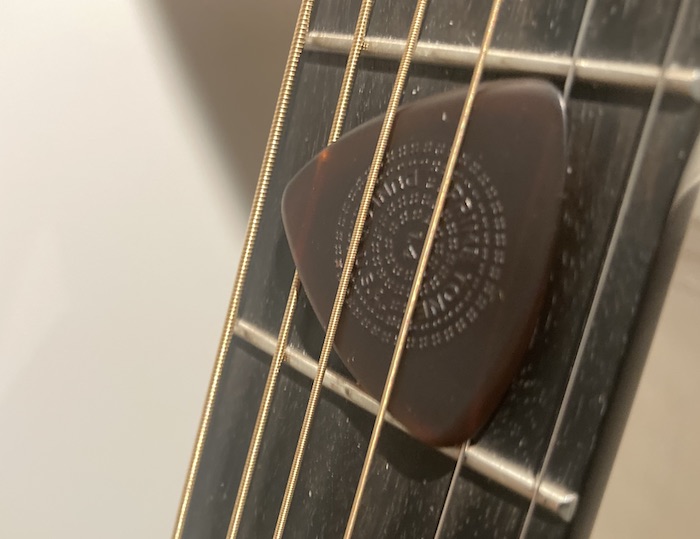
I got a pack of three picks for less than half the cost of a single high-end pick, and they are fantastic. They’re made of Ultex, a polyetheramide plastic, and nicely beveled around the edges. I got the regular triangle shape in the 1.4 mm size, and it’s pulling a fatter tone out of my D-18 than even my old Red Bear pick that lasted me more than a decade. I don’t know how this one will wear, but hey—there’s another in the case and one more in the bag.
My favorite thing about these picks is the grip, courtesy of raised lettering on the surface. I jammed for three hours last night and the pick did not budge, not even once. Seriously, if you’re opposed to spending $35-$50 on a pick just on principle, give these Primetones a try.
Now that I’ve let you in on my little secret, let’s get to the tried-and-true best bluegrass guitar picks. Most flatpickers would agree on these, even if they might shuffle the order a little bit.
Best bluegrass guitar picks
BlueChip
Everyone has their favorite, but I’d wager that BlueChip is the favorite of more bluegrass flatpickers these days than any other chip.
Many pickers say it’s as close to tortoise shell as you can get without playing the real thing. Of course, playing real tortoise shell has some issues, which I’ll get into later.
BlueChip picks are especially lauded for their grip. They do not slide around in your fingers. This is handy when things start to heat up at the jam.
They offer great control, even as they move very quickly through the guitar strings. You have to like a pick that sticks to your fingers but not to your strings.
Extra noise from the picks is also very limited, and they are probably durable as just about any comparable competitor on the market.
But which one to get?
That will be a matter of personal preference, but I suggest you try something in the TAD, TP or TPR series. These are all triangular picks. The TAD is slightly larger than the other two. The TP has a slightly sharper corner than the TPR.
In each series, the number at the end of the model name indicates the thickness of the pick, in 1/1000s of an inch.
Red Bear
Red Bear Trading Co. was a bit of a pioneer in manufacturing picks that looked, felt and sounded an awful lot like tortoise shell. That was a while ago, though, and the truth is that several companies are now using similar materials and Red Bear doesn’t have the competitive advantage it used to.
They’re still great picks, though—as long as they last. Mine made it to 14 years before it suffered a hairline fracture. But plenty of people have had Red Bear picks crack on them much earlier, for no good reason. I’ve heard the stories.
Another potential issue with Red Bears—and I’ve had this happen—is that they can soften in the heat and humidity so that they curve themselves slightly along the contour of your thumb. Then they firm up, and the subtle shape becomes permanent. You end up with a pick that is slightly curved in the shape of your thumb. You can still play it, but you have to hold it the same way very time. If you flip it over, it feels terrible.
Look, if you get a good one, Red Bears can’t be beat. The tone is superb, and they make almost no pick noise against your strings.
They come in a number of shapes and sizes that you can peruse on the Red Bear website. You can even get ones with little holes in the surface for extra grip, although I’ve never found grip to be a problem.
Wegen
I’ve never been able to get used to them myself, but Wegen picks have just as many devotees as Red Bears, if not more. These little picks are made in the Netherlands by a guy named Michel Wegen whose website is very ’90s.
He even makes a dedicated “Bluegrass” model, but for my money the TF140 is the way to go. The Bluegrass picks are teardrop-shaped and I find the point can get a little hung up on the guitar strings at faster tempos. I much prefer the corner on the larger, triangle-shaped TF140.
Apollo
You’ll also hear a lot about Apollo picks. I’ve never held one myself, but the reviews are really solid and you can tell just by the pictures on their website that Apollos are the real deal.
If you’ve got a little extra money to spend, I bet you’ll be pretty happy with one of those. If you get one, let me know and maybe I’ll plug your review right into this space.
Choosing a bluegrass guitar pick
The best bluegrass guitar pick for you will almost certainly be different than the best one for me. As you try them out and decide what you like, these are some of the factors you’ll want to think about.
Size
Guitar picks don’t really come in designated sizes, but you’ll come across some that are small, some that are large, and some that are in between. Generally, guitarists with larger hands gravitate toward larger picks, but there are exceptions. I have big hands, and I find that with a small pick there’s a greater chance of it slipping out of my hand.
Another advantage of larger picks is that you can try holding them several different ways. For example, many pickers like the warm tone they get from using the shoulder of a teardrop-shaped pick, rather than the point. But that’s hard to do if you’re using a really small pick.
Try them all and see what you like.
Shape
For the most part, bluegrass guitar picks are either tear-shaped or rounded triangle. But you can get variations within those general types. Some teardrop picks are almost like half circles at the non-pointy end, while others have distinct ‘shoulders’ on them. Likewise, triangle picks vary greatly in the sharpness of their points, and some will even provide a slightly different shape on each point of the triangle.
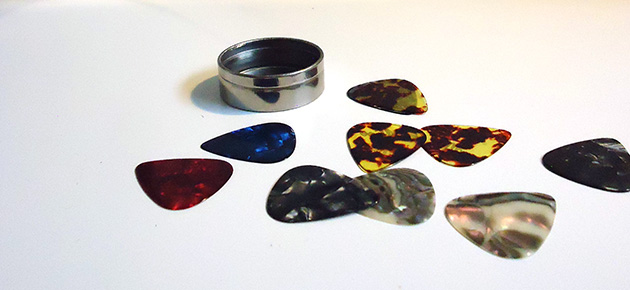
Thickness
For the most part, bluegrass flatpickers like thick picks. How thick is entirely up to you. Anyone who’s spent their entire guitar-playing life picking at an electric guitar with a flimsy plastic pick will be astonished at the thickness of a typical bluegrass pick.
It makes sense, though. Acoustic flatpicking is all about tone, and the last thing you want to hear is your pick going ‘clackety-clack’ against the strings while you’re trying to pull the richest possible sounds out of your guitar. A heavier pick produces a fatter, more rounded tone, with less pick noise.
Furthermore, thin picks store kinetic energy when they bend against the strings, delaying the guitar’s response to your picking. As an acoustic flatpicker, you want ALL the kinetic energy from your pick stroke being transferred straight to the strings. Don’t forget, you’re trying to be heard alongside banjos and fiddles!
Material
Most guitar picks are made of plastic, but not all plastics are created equal. The high-end picks we’ve mentioned above use very specialized plastics to give them that special feel that resembles tortoise shell.
In the case of BlueChip picks, it’s a polyamide-based plastic called Vespel. Red Bear picks use a synthetic plastic called Galalith, which is made from a milk-based protein called casein combined with formaldehyde.
Nylon and celluloid are also popular synthetic materials for picks.
You’ll find some picks made of glass, stone or wood, and they can work well depending on how they are finished.
But the most infamous natural material for guitar picks is tortoise shell.
Are tortoise shell picks illegal?
Not all tortoise shell guitar picks are illegal, but some are. It depends whether the particular species is covered by the Convention on International Trade in Endangered Species of Wild Fauna and Flora (CITES), and whether the pick was made prior to 1973 when international trade in tortoise shell became banned.
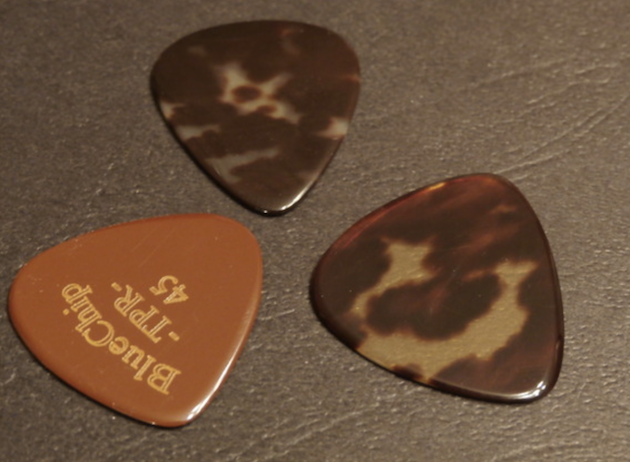
If the shell used in your pick was harvested and manufactured before the protection for endangered tortoises came into effect, then you’re OK. If it wasn’t, then you can’t buy it, sell it, cross borders with it, and probably shouldn’t tell anyone you have it.
It’s very hard to prove when tortoise shell was harvested without proper documentation, and very few people have this. There are countless stories of musicians running into trouble for trying to carry tortoise shell picks (or Brazilian rosewood guitars) across borders without proper documentation.
If you happen to have a tortoise shell pick, first, lucky you, and second, you’re better off not traveling with it.

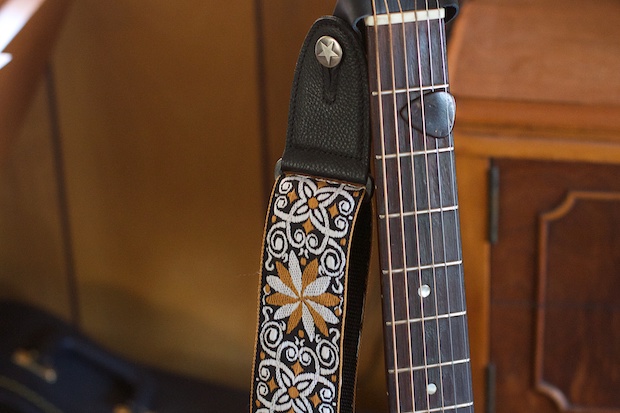
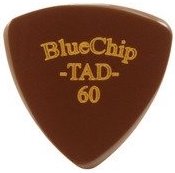
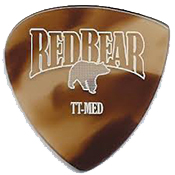
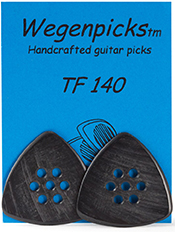
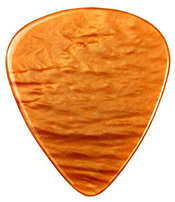
Nice review! Thanks much. I just got my first set of Dunlop Primetones and really like the grip. Unfortunately I bought 1.5mm triangular picks – which seem both too thick and too large for me – but just ordered some 1mm standard shapes, which I suspect will be much more comfortable. (Have an HD-28 V & play bluegrass/oldtime/irish fiddle type tunes mostly.)